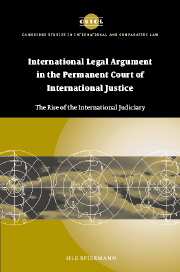 International Legal Argument in the Permanent Court of International Justice
International Legal Argument in the Permanent Court of International Justice Book contents
- Frontmatter
- Contents
- Foreword
- Acknowledgments
- Table of cases
- Table of treaties
- List of abbreviations
- Part 1 The Permanent Court of International Justice
- Part 2 International legal argument
- Part 3 International legal argument in the Permanent Court of International Justice
- 4 Revisiting the Permanent Court
- 5 The foundational period, 1922–1924
- 6 An international lawyer's approach, 1925–1930
- 7 A national lawyer's approach, 1931–1940
- Part 4 General conclusions
- Appendix: List of Advisory Opinions, Judgments and Orders of the Permanent Court of International Justice
- Bibliography
- Index
- CAMBRIDGE STUDIES IN INTERNATIONAL AND COMPARATIVE LAW
7 - A national lawyer's approach, 1931–1940
Published online by Cambridge University Press: 17 July 2009
- Frontmatter
- Contents
- Foreword
- Acknowledgments
- Table of cases
- Table of treaties
- List of abbreviations
- Part 1 The Permanent Court of International Justice
- Part 2 International legal argument
- Part 3 International legal argument in the Permanent Court of International Justice
- 4 Revisiting the Permanent Court
- 5 The foundational period, 1922–1924
- 6 An international lawyer's approach, 1925–1930
- 7 A national lawyer's approach, 1931–1940
- Part 4 General conclusions
- Appendix: List of Advisory Opinions, Judgments and Orders of the Permanent Court of International Justice
- Bibliography
- Index
- CAMBRIDGE STUDIES IN INTERNATIONAL AND COMPARATIVE LAW
Summary
The Permanent Court as composed after the second general election
President Adatci and other new judges
The second general election of judges took place on 25 September 1930. Those re-elected were Judges Altamira (sixty-four years old), Anzilotti (sixty-one years old) and de Bustamante (sixty-five years old), who had been ordinary members of the Permanent Court since 1922; Judges Negulesco (fifty-five years old) and Wang (forty-nine years old), who had also been members of the Permanent Court since 1922, though in the first nine years as deputy-judges; and Judges Hurst (sixty years old), Fromageot (sixty-six years old) and Kellogg (seventy-four years old) (ages stated as at the end of 1930).
Only Judges Negulesco and Wang were younger than Judge Huber; Judge Huber, however, had eventually declined to stand for re-election. Huber's influence had diminished during Judge Anzilotti's presidency, partly because he had taken up the presidency of the International Committee of the Red Cross. Yet his departure was a serious blow to an international lawyer's approach to international legal argument, one which combined the international law of coexistence with the dynamic structure of international legal argument, having the conception of the state as an international sovereign as its starting-point. The main exponent of this approach remaining on the bench was Judge Anzilotti, since Deputy-Judge Beichmann did not secure re-election. Indeed, no Scandinavian candidate succeeded. Åke Hammarskjöld lost the last seat on the bench by a whisker to a South American, Francisco José Urrutia (Colombia).
- Type
- Chapter
- Information
- International Legal Argument in the Permanent Court of International JusticeThe Rise of the International Judiciary, pp. 300 - 390Publisher: Cambridge University PressPrint publication year: 2005
